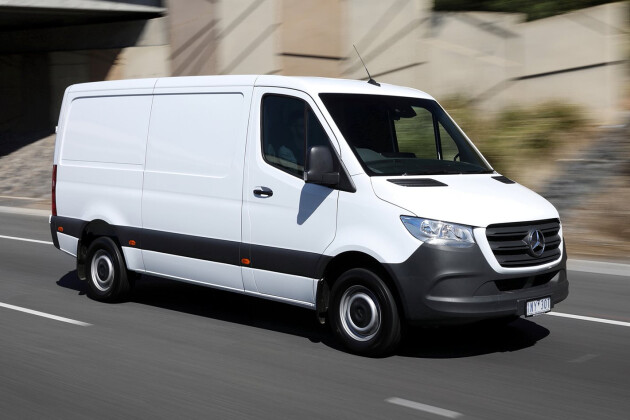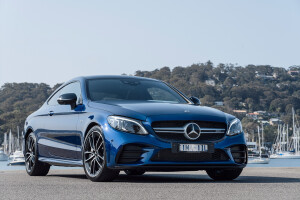Latest Review

2019 Mercedes-Benz Sprinter Review
The new generation Mercedes-Benz Sprinter range has hit Australian roads, but does the longstanding leader in the large van class have what it takes to keep top spot?
Mercedes-Benz’s Sprinter has comfortably ruled the large van segment in Australia for more than a decade, but Benz has upped the ante with its third generation release to deliver what it says is the most technologically-advanced light commercial vehicle on the market.
Beyond that, the range is bigger than before. New to the Sprinter line-up are a number of front-wheel drive models to supplement existing rear-wheel drive and all-wheel drive options. With the range now offering more than 1,700 different variants based on combinations of body type, powertrain, cab configuration, length and cargo space height, prospective customers are spoiled for choice.
The front-drive Sprinter is offered with a 9-speed automatic or 6-speed manual and brings with it a 50kg higher payload, 80mm lower loading edges and most importantly the lowest price point of the Sprinter range.
This is the first time we’ve seen a nine-speed auto torque converter transmission in the large van segment too, following the direction of the passenger car market and its appetite for endless ratios. A manual gearbox option is of course still offered but the manufacturer tells us that unsurprisingly, around 98% of Sprinters are now equipped with automatic gearboxes.
VALUE
The manufacturer’s recommended list price (MLRP) for the Sprinter starts at $41,238 for the base model front-wheel drive cab-chassis, and $46,008 for the base-model van.
If you want the 6-cylinder powertrain, you’re looking at a starting price of $72,434 for the van and $64,114 for the cab-chassis. Fuel economy ranges from 6.8l/100km in the most efficient 4-cylinder, through to a thirstier 9.7l/100km for the larger models.
As for after-sales coverage, the entire Sprinter range has service intervals of 40,000 kilometres or two years, and a 200,000km/three year warranty. On top of this, Mercedes-Benz throws in Standard Roadside Assist at no extra cost during the manufacturer warranty period, giving customers 24/7 coverage around Australia.
Van and cab-chassis models are available from this month in Australia, followed by the minibus and tractor head versions early next year.
STANDARD FEATURES
Technology offered as standard across the new Sprinter range is focused on two things; user experience and safety.
The introduction of Mercedes-Benz User Experience (MBUX) infotainment, borrowed from the company’s passenger car range, brings with it a connected user experience you’d expect in high-end cars and SUVs.
A 7-inch HD touchscreen display or optional 10.25-inch display sits at the heart of the MBUX multimedia system, which debuted earlier this year in the new-generation A-Class. From the driver’s seat the MBUX steering wheel controls proved far simpler than previous systems and coupled with the touchscreen, navigation of the multimedia system was foolproof.
Voice control, a system developed in-house by Mercedes-Benz, aims to connect the user to the vehicle with two simple words: “Hey Mercedes.” By comparison with ubiquitous voice command options like Siri and Google Assistant, the Mercedes-Benz system operates offline and seems more focused on efficiency than entertainment. For example, setting navigation destinations and switching on the seat warmers can be done entirely by spoken commands, reducing the potential for driver distraction.
For those who prefer a smartphone-based system, Android Auto is currently offered across the new range and Apple Carplay is coming later this year.
A telematics-style fleet management system is also coming next year called Mercedes PRO, offering vehicle and driver location, digital driver’s logbook, vehicle logistics, fleet communication, and maintenance management.
SIZE
From a payload perspective things haven’t changed much as all variants of the Sprinter can still be driven on a standard vehicle licence, from the short wheelbase models right through to the extra-long wheelbase with high roof.
Maximum GVM across the range is 5 tonnes, with a 2,929kg payload and 17m3 load capacity on the rear-wheel drive 6-cylinder 519CDI Sprinter.
European markets do receive a 5.5 tonne GVM model but we were informed the Australian market is yet to receive the larger specification.
For tradies, couriers and everyone in between, the van’s loading length up to 4810mm is enormous when compared with typical dual-cab utes which offer in the vicinity of 1400-1600mm of length.
This comes in a package with a vehicle width similar to that of a large 4X4 wagon.
SAFETY
The myriad of safety tech the Sprinter receives out of the box is class-leading in this segment, ranging from Lane Keeping Assist through to the driver-focused Attention Assist.
That feature set is more or less on par with modern passenger vehicles too, offering radar-based cruise control, active brake assist, active lane keeping assist, driver fatigue monitoring and rain-sensing wipers.
A plus for drivers spending large amounts of time doing highway speeds is that the stability-enhancing Crosswind Assist remains standard, again a feature typically reserved for cars.
Front driver and passenger airbags as well as window bags are standard across the Sprinter range.
COMFORT
The agricultural seats, steering wheel and ergonomics we’ve come to tolerate in commercial vehicles have been replaced with items that wouldn’t feel out of place in something like Mercedes-Benz’s A-Class.
A long-standing gripe with commercial vehicles shared between drivers is back-and-forth driver adjustments. An optional electrically adjustable front seat option brings a memory function to the new Sprinter, storing mirror and seating settings for up to three drivers. Sole traders may not get much use out of it, but anyone sharing one van among a number of employees definitely would.
Of course, there are still the access and visibility hallmarks of a commercial vehicle but for the most part this cabin provides a working environment that’s considerably more premium than the average tradie-grade van.
ON THE ROAD
The one-day drive program took us through the scenic Adelaide hills, providing urban, highway, and country driving across a range of models and load types.
From a performance perspective, while outright acceleration isn’t of great concern within the van segment, these are more often than not last-mile delivery vehicles so a bit of haste doesn’t go astray.
Engine options remain the same as the previous generation Sprinter, although power outputs are boosted. Mercedes-Benz remains the only manufacturer within the van segment to offer a six-cylinder, with the range-topping 3-litre diesel delivering 140kW and 440Nm from a low 1,6000rpm.
Meanwhile the 2.1-litre 4-cylinder diesel workhorse is offered in both single and twin-turbo guise, with outputs ranging from 84kW/300Nm to 120kW/360Nm.But it’s the Sprinter’s grunty six-cylinder option that’s the pick of the bunch, simply due to the effortless torque from low revs which makes all the difference when fully loaded.
The big six lugs along unstressed and doesn’t require much right foot motivation to get up to speed, making it an attractive option for those looking to spend a lot of driving time up near maximum GVM.
The 4-cylinder diesel is also surprisingly punchy in twin-turbo form, offering up 105kW and 120kW - ample power around town.
Of the 4-cylinder options the 120kW four was a far better on-highway performer than the 105kW spec, with enough puff to overtake comfortably and plenty of go in urban city scenarios.
A base-spec 84kW engine option is available, perhaps better suited to ‘around town’ work as it provides a little less pull than many will desire but at a price-point that’s hard to go past.
VERDICT
Simply put, the Sprinter has never been better to drive. In fact, this has got to be the most comfortable van we’ve driven to date.
For everyday use, the new front-wheel drive options offer improved access, payload and lower price points for short and medium wheelbase van and single cab-chassis buyers.
If you’re looking at purchasing a long or extra-long wheelbase Sprinter, the tried and tested rear-wheel drive platform is the only option and you’ll have access to the 6-cylinder engine as well as the more economical four-pot.
In terms of gearbox choices, both the 7-speed and 9-speed automatic suited the array of driving we did, and depending on budget both will fit the bill for most urban uses.
The trend across the LCV vehicle market to provide a ‘car-like’ driving experience is something Mercedes-Benz has managed to convincingly achieve with the new Sprinter.
Take Mercedes-Benz’ renewed focus on safety, user-connectedness and comfort and add to that the winning practicality that shot the previous Sprinter to the top of its class, and this new generation looks set to hold its own in the red-hot LCV space.
News
-
 News
News2018-2020 Mercedes-Benz Sprinter van recalled over parking fault
Almost 1000 vans are being placed under recall
-
 News
News2021 Mercedes-Benz Sprinter recalled for electrical issue
A new recall issued by Mercedes-Benz Australia affects just 31 vehicles
-
 News
NewsMercedes-Benz to offer electric vans and people-movers locally from 2022
Three new electric Mercedes-Benz vans are set to land in Australia next year, with more to follow
-
.jpg) News
NewsMercedes-Benz recalls 2014-2018 Sprinter van
Almost 900 vehicles are involved in the notice
-

Mercedes-Benz recalls 2017-2021 Sprinter van over steering fault
-

Mercedes-Benz Sprinter vans recalled over risk of front brake failure
-

Multiple recall notices issued for Mercedes-Benz models
-

Mercedes-Benz Sprinter recalled over parking brake failure

